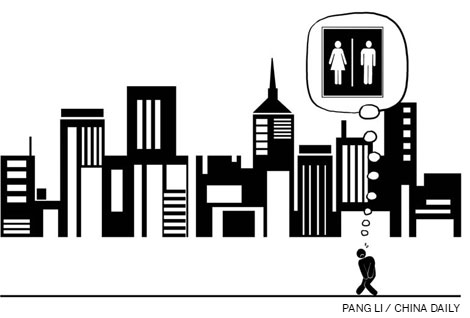In a developing country, the shift of public attention to issues such as public toilets is reflective of the society's progress. Public toilets are important "infrastructure" related to public health and in China deserved greater public attention on World Toilet Day on Tuesday.
Last month hundreds of runners urinated outside the Forbidden City during the Beijing Marathon, which was a major embarrassment for the event organizers who were blamed for failing to provide enough mobile toilets. Two months before this, new legislation in Shenzhen, stipulating that the users of public toilet in the city will be fined 100 yuan ($16) for missing the mark, received more derision than applause, due to the impossibility of enforcing it. Recent years have also seen several high-profile campaigns launched by women to "occupy" men's washrooms, in a bid to get more facilities for women. Pit latrines, squat toilets, buzzing flies and unpleasant smells, public toilets in China used to be a major intimidation to foreign travelers after China opened the door in 1980s. One of my Singaporean friends keen to take his young children for a second visit back to rural Hainan, to get closer to the family's roots, was quickly rebuffed by the kids who were scared of the toilets in China's countryside.

Ensuring there are clean toilets is a public health imperative, unsanitary latrines have been a breeding ground for many communicable diseases in rural China. The government has made great efforts to upgrade toilet facilities since it was recognized as a vital public health task 20 years ago, and the task is one of the five key public health commitments in China's ongoing national healthcare reform. The intermediate goal is to have 75 percent of rural toilets upgraded by 2015, but this is easier said than done given that in the vast underdeveloped regions, having a clean latrine is yet to be a must. Compounding this is budget constraints. Thanks to the government's strengthened financial muscle, full subsidies or matching funds have been made available as financial incentives to encourage rural households to upgrade their toilets. Yet, a more challenging job in the long run is to promote healthy lifestyles including hygienic behavior. The use of sanitized flush toilets is merely the start.
Cities, too, need a toilet revolution. Although there is certainly a room for improving the infrastructure, the main challenge is changing people's mindsets. A couple of years ago, the proposal of a university president in East China to supply free toilet tissue stirred widespread reservations and skepticism on campus, but in the end, this became something that the faculty and students took pride in. But in general, people have yet to become accustomed to seeing toilet paper in public toilets. Trial efforts to supply free toilet paper have been frustrated by its frequent disappearance. But we should bear in mind it takes time to educate a generation. More troublesome is the inadequate supply of women's toilet stalls in cities. While in many international cities it is common to see a higher proportion of toilets for females, the 1:1 ratio, however, still remains in China.
In public places and tourist attractions, long queues outside women's washrooms are a common sight throughout the country. Unfortunately, the campaigns by women and the media attention they have attracted do not seem have made any difference. A more caring official mindset and concrete actions would serve women much better than the usual rhetoric of gender equality. China is in the midst of rapid urbanization, but it appears that policymakers' attention has yet to truly go beyond airports, highways, commercial centers, and residential buildings. As a window revealing both the level of civilization and public health achievements, public toilets are no longer a trivial matter for policymakers. An integrated policy approach is needed to guide the development of both the infrastructure and people's mindset. While ensuring there is an adequate supply of quality public toilets, issues such as the gender ratio, supplies of tissue and soap, privacy and barrier-free access for the disabled must be given attention. In the countryside, aside from upgrading, more initiatives such as ecologically engineered toilets, and recycling human waste as fertilizer should be encouraged.
Furthermore, while the government certainly plays a central role as the issue concerns the public good, it also requires the efforts of NGOs, R&D institutions, industries, and communities as well. Above all, we need the whole of society to recognize that toilets are not simply an issue of infrastructure, but also one that requires greater awareness of their public health, education, environmental and cultural implications.
The author is an assistant professor at the Department of Asian and Policy Studies at Hong Kong Institute of Education.
(China Daily 11/22/2013 page9)